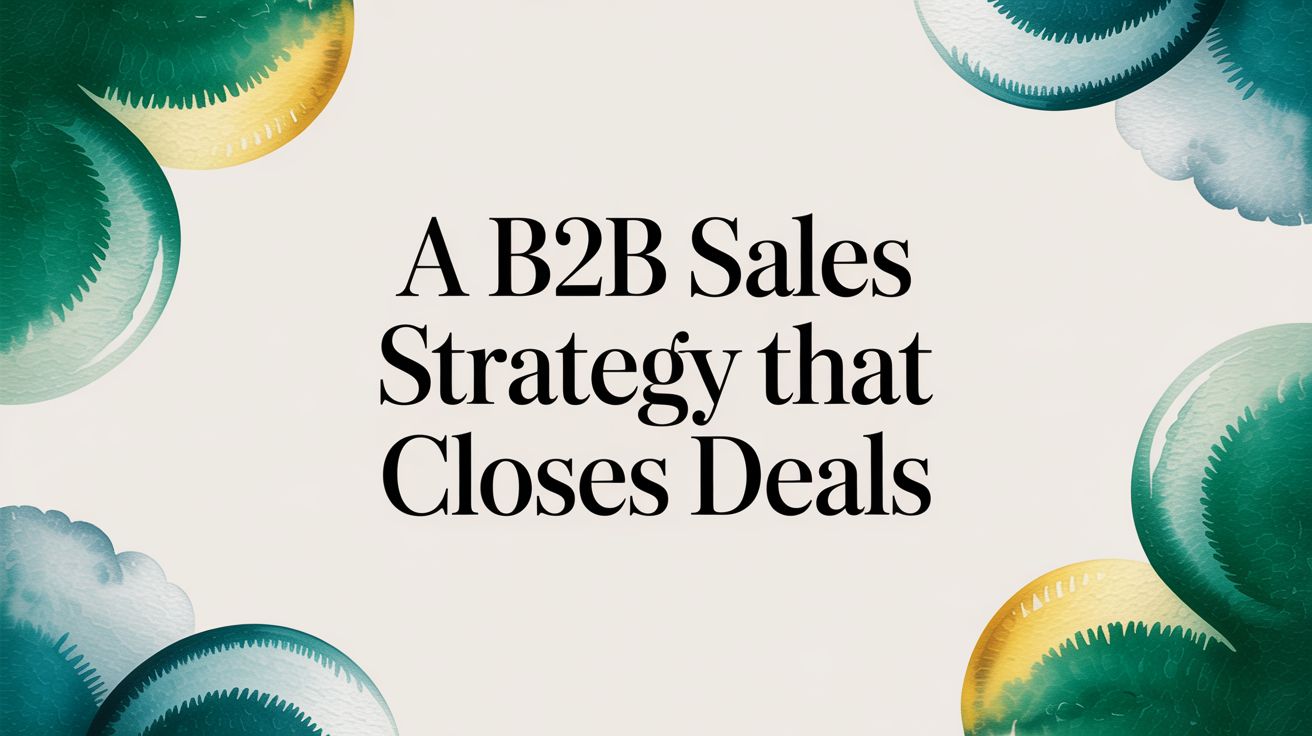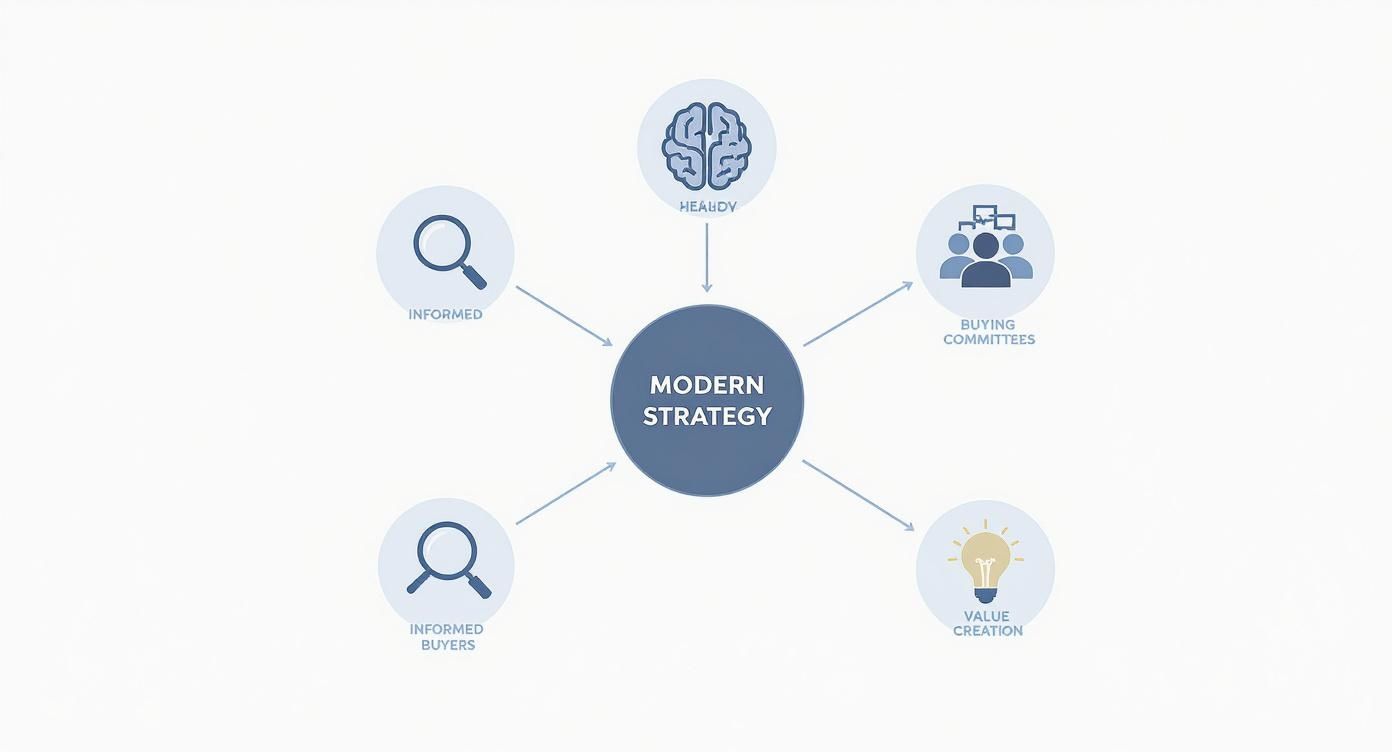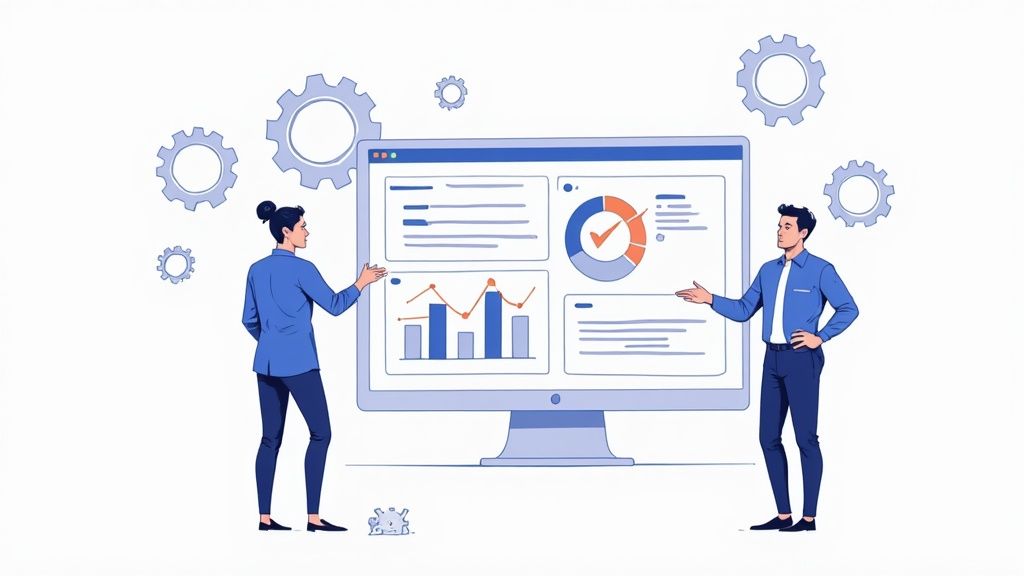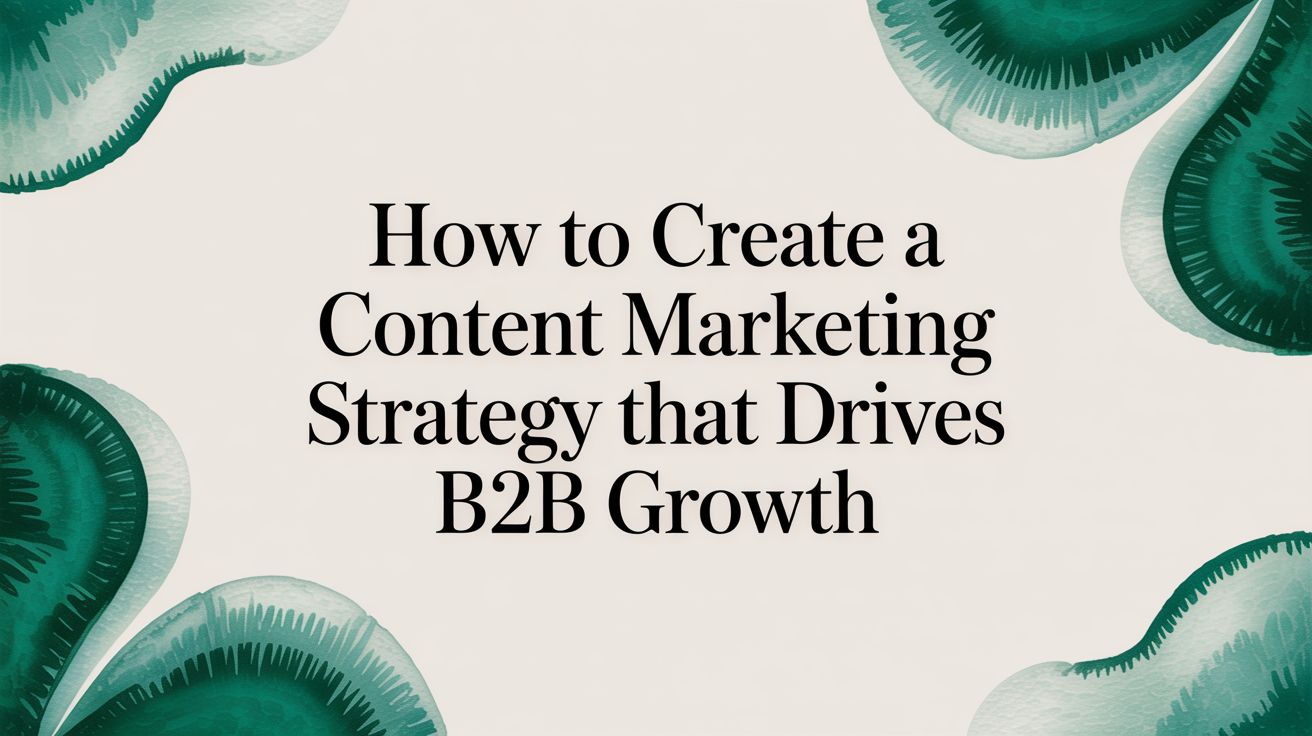A B2B Sales Strategy That Closes Deals
October 22, 2025

A successful b2b sales strategy isn't just a document—it's a dynamic plan for how your team finds, engages, and ultimately closes deals with other businesses. Think of it as a blueprint built for today’s incredibly informed buyers, one that focuses on creating undeniable value long before a contract is ever on the table.
What a Modern B2B Sales Strategy Looks Like
First, let's agree to move past outdated playbooks. The old, linear sales funnel is broken simply because modern B2B buyers don't follow a neat, predictable path from A to B. They jump around, do their own research, and show up armed with information.
Today, a powerful strategy is an adaptable approach designed to meet sophisticated business buyers exactly where they are. This means the entire game has shifted from transactions to relationships.
This infographic breaks down the core pillars of a modern strategy: you're dealing with highly informed buyers, navigating complex buying committees, and facing an absolute necessity to create value at every turn.

What this really highlights is that success depends on navigating these three interconnected areas all at once, not treating them like separate steps in a process.
Meeting the New Buying Reality
The game has changed because the players have. B2B purchase decisions now involve an average of 7.4 decision-makers, and a staggering 70% of the buyer's journey is often complete before they even speak to a sales rep. This isn't just a small shift; it's a fundamental rewiring of how deals get done.
Your strategy now has to educate and influence multiple stakeholders simultaneously, well before anyone picks up the phone for a formal sales call.
The core mission of a modern B2B sales strategy is to become a trusted advisor, not just another vendor. It’s about understanding a client’s business so deeply that you can offer solutions they haven’t even thought of yet.
Your entire approach must be built on deep, genuine customer insight. This means creating a system where you are constantly learning about your prospect's challenges, goals, and internal politics.
When your teams are perfectly in sync, this process becomes much smoother. For more on this, our guide on aligning sales and marketing is a great place to start. True alignment ensures that the insights gathered from marketing efforts directly fuel more effective and relevant sales conversations, creating a seamless experience for the buyer from start to finish.
Building Your Foundational Sales Framework
Before any sales team can start closing deals like clockwork, they need a solid playbook. A strong sales framework isn’t about creating a bunch of rigid, soul-crushing rules. It's about building a shared, crystal-clear understanding of who you’re selling to, how they make buying decisions, and what success actually looks like.
Think of it as the essential groundwork that transforms a reactive, "winging it" sales approach into a proactive, repeatable system built for growth.

This whole process kicks off by defining your Ideal Customer Profile (ICP) with almost surgical precision. You have to move way beyond basic firmographics like company size or industry. A truly powerful ICP gets under the hood to uncover the real pain points, operational headaches, and buying triggers that make a prospect a perfect match for what you offer.
Pinpoint Your Ideal Customer
To build an ICP that actually works, you need to answer some tough questions that go deeper than surface-level data. Getting this clarity is the first real step toward building an efficient sales engine.
- What specific problems are keeping them up at night? Don't think big and abstract; focus on the day-to-day operational chaos you can actually solve.
- What are their big-picture business goals? You need to connect the dots between your solution and their high-level objectives, whether that's boosting revenue or gaining market share.
- What does their buying process really look like? Get granular. Identify the key decision-makers, the internal influencers who have their ear, and the potential blockers who could derail the whole deal.
Answering these questions turns your ICP from a static document gathering dust into a dynamic tool your team can use every day. As you build this out, knowing how to implement effective 10 proven B2B lead generation strategies is what will fill your pipeline with these perfect-fit clients.
To help you get started, here's a simple framework to guide you from broad ideas to specific, actionable customer details.
Ideal Customer Profile (ICP) Development Framework
Using a structured approach like this ensures you're not just guessing. You're building a profile based on real-world characteristics that predict success.
The goal isn’t to sell to everyone. It’s to find the specific businesses that cannot succeed without you and focus all your energy there.
Once your ICP is dialed in, mapping the customer journey is the next logical step. By truly understanding how your ideal customers research solutions, weigh their options, and ultimately make a decision, you can align your sales activities to their natural buying rhythm.
This journey map brings to life the moments where your message will hit hardest. It’s also a cornerstone of any well-defined process, and you can learn more about how it all fits together in our guide to the B2B sales funnel.
How to Engage the Modern B2B Buyer
Engaging today’s B2B buyer is no longer about having the loudest voice; it’s about being the most helpful one. Your prospects are now in the driver's seat, directing their own buying journey by consuming content, comparing solutions, and forming solid opinions long before they ever agree to a demo.
This means your whole strategy has to pivot. Forget direct selling. You need to start guiding them with genuinely valuable information that answers their questions before they even have to ask. The goal is to create high-value content—think insightful blog posts, in-depth whitepapers, and real-world case studies—that hits on their specific pain points and positions your brand as a trusted authority. It’s a consultative approach that builds credibility from the very first touchpoint.
Personalize Your Outreach
Let's be honest: generic, one-size-fits-all emails are a fast track to the delete folder. Real engagement comes from personalization that goes way beyond just slotting in a prospect’s first name. It requires a deep, almost obsessive, understanding of their role, their company's unique challenges, and the trends shaping their industry.
This is where your detailed customer profiles become your most valuable asset. Tailor every piece of communication to reflect their specific situation, showing you've actually done your homework. Creating detailed buyer personas is a critical first step, as it helps you get inside their head and understand the motivations driving their decisions. You can learn more about using buyer personas to accelerate B2B marketing and sales in our dedicated guide.
Build Connections Through Social Selling
Platforms like LinkedIn offer a direct channel to your prospects, but treat it like a conversation, not a billboard. Aggressive sales pitches on social media are a huge turn-off. The most effective b2b sales strategy is built on genuine connection and a fair exchange of value.
Here's how to do it right:
- Share relevant industry insights: Post articles and data that actually help your audience do their jobs better.
- Engage with their content: Don't just "like" their posts. Leave thoughtful comments to start a natural conversation.
- Join relevant groups: Participate in discussions to establish yourself as a knowledgeable resource people can turn to.
This approach builds relationships over time. It makes your eventual outreach feel like a natural next step rather than an unwelcome interruption.
The most powerful shift in modern sales is moving from 'selling to' buyers to 'partnering with' them. When you act as a consultant focused on their success, the sale becomes a natural outcome of the relationship.
This pivot to a more consultative, omnichannel presence is a direct response to huge market changes. The global B2B eCommerce market is on track to explode, projected to grow from $13.29 trillion in 2019 to $32.11 trillion by 2025. That’s a clear signal that business buyers are getting more and more comfortable making big decisions in digital channels.
Want more proof? Explore the latest B2B marketing statistics. This digitization means your engagement strategy must be completely seamless across every single platform where your buyers are active.
Using Technology to Amplify Your Sales Team
Let's be clear: technology should be a force multiplier for your sales team. It's the tool that clears away the administrative clutter so they can focus on what they do best—building relationships and closing deals. The goal is never to replace skilled salespeople. It's about equipping them with intelligent tools that sharpen their instincts and expand their reach.

This whole process starts with reimagining your Customer Relationship Management (CRM) system. Too often, a CRM becomes a glorified digital filing cabinet—a place where data goes to die. It needs to be the strategic heart of your entire sales operation. Think of it as a dynamic hub for uncovering deep customer insights and managing every single interaction with precision.
When you set it up correctly, a CRM gives your team a complete, 360-degree view of the customer journey. This helps them anticipate needs and deliver real value at exactly the right moment, turning reactive follow-ups into proactive consultations.
Smart Automation and AI Integration
Sales automation is really about one thing: reclaiming your team’s most valuable resource—time. By automating the repetitive, low-value tasks like data entry, scheduling, and mindless follow-up reminders, you free up your people to concentrate on high-impact activities. That means more time for strategic conversations, complex problem-solving, and building genuine rapport.
The next layer here is the smart application of artificial intelligence. Top B2B companies are heavily investing in AI-driven capabilities to sustain both productivity and growth. According to Bain & Company, this focus on tech integration for tasks like lead scoring and creating custom sales approaches is a key factor separating the best from the rest. You can discover more about this commercial excellence agenda at Bain.com.
Technology’s true power in a B2B sales strategy lies in its ability to handle the science of selling, freeing up your team to master the art of it.
AI-powered tools are incredible at analyzing massive amounts of data to predict which leads are most likely to convert, allowing your team to prioritize their efforts where they’ll have the most impact. This predictive power also extends to sales forecasting, giving you far more accurate revenue projections to work with.
For a deeper dive into specific platforms that can make this happen, check out our guide on the top AI tools for B2B marketing and sales in 2025. Picking the right stack is what turns raw data into actionable intelligence and gives your team the edge they need to win.
How to Measure and Refine Your Sales Process
A winning B2B sales strategy isn't a static playbook you set once and forget. It's a living system, one that needs to be fed a steady diet of real-world data to stay sharp. The goal is to move beyond celebrating closed deals and start digging into the numbers that reveal the true health of your entire sales operation.

This is about creating a powerful feedback loop. Every insight from a sales call and every piece of customer feedback should directly inform your next move. Think of every conversation as a data point—a chance to sharpen your approach.
Key Metrics for a Healthy Sales Operation
Before you can start refining anything, you need a clear, honest picture of your performance. You don't need dozens of metrics; just focus on the few critical indicators that give you the most insight.
- Sales Cycle Length: How long does it actually take to move a prospect from that first touchpoint to a signed contract? If you see this number getting shorter over time, it’s a strong sign your messaging and process are hitting the mark.
- Conversion Rates by Stage: Where are your deals really stalling out? Knowing if prospects are dropping off after the demo versus during contract negotiation helps you pinpoint specific weaknesses in your B2B sales process so you can fix what's actually broken.
- Customer Lifetime Value (CLV): This is the ultimate measure of long-term success. A high CLV tells you you’re not just closing deals, you’re acquiring the right customers who stick around because they get lasting value from what you offer.
A culture of continuous improvement isn't about finding blame; it's about finding opportunities. Every metric, good or bad, is a signpost pointing toward a smarter way to work.
Pipeline reviews are a goldmine for this kind of learning, but only if you ask the right questions. Instead of just asking, "Will this close?", start asking, "What did we learn from this interaction?" This one small shift changes the entire focus from simple forecasting to strategic learning.
You should also be running simple A/B tests on your outreach. Pit different value propositions in your emails against each other. Try out a few different calls to action in your call scripts. This data-driven approach removes the guesswork and builds a strategy that constantly adapts based on what your customers are actually telling you, not what you think they want to hear.
Answering the Tough Questions on B2B Sales Strategy
Even the most buttoned-up strategy is going to spark a few questions. And that’s a good thing. A solid B2B sales strategy isn't just about what to do; it's about knowing why you're doing it and having clear, confident answers for your team when the inevitable challenges pop up.
Let's tackle a couple of the most common hurdles I see sales leaders run into when they start putting a new plan into motion.
How Do We Actually Get Sales and Marketing on the Same Page?
True alignment between sales and marketing isn't about forcing everyone into more joint meetings. It's about shared goals and, more importantly, shared data. The shift really happens when Marketing’s success is no longer measured by the sheer volume of leads but by the actual revenue those leads generate.
It starts with both teams agreeing on a crystal-clear definition of a qualified lead. No more ambiguity. You also need to be working from the exact same customer profile.
A practical first step? Create a shared dashboard that tracks the entire journey, from the very first marketing touchpoint to the final signed contract. When you have that level of transparency, everyone is working from the same playbook. Insights from both sides stop being points of contention and start becoming fuel for growth.
The real goal here is to create a buyer experience that feels completely seamless. From the first ad a prospect sees to the final negotiation, the messaging, value prop, and tone should all feel like a single, unified conversation.
When you nail that consistency, you build trust much faster, which in turn accelerates the entire sales cycle.
What’s a Realistic Timeline for Seeing Real Results?
This is where leaders need to manage expectations. Patience is a virtue, but you also need to build and maintain momentum. While a brand-new B2B sales strategy can take 6-9 months to fully mature and show a major impact on the bottom line, you absolutely should be seeing signs of life much, much sooner.
Focus on tracking the leading indicators to build confidence and prove the strategy is working.
- In the first month: You should see a noticeable uptick in qualified meetings being set. Are reps having more of the right conversations?
- Within two to three months: Start looking for higher conversion rates at the top of the funnel. Are more of those initial conversations turning into legitimate opportunities?
- By months four to six: You should begin to see the sales cycle length for new deals getting shorter.
Tracking these early metrics gives you the data-driven proof that you’re on the right path, long before those big, company-changing deals start to close. It keeps the team energized and focused on executing the process, not just waiting for the outcome.
Big Moves Marketing specializes in building the positioning, sales tools, and launch strategies that help B2B SaaS and AI startups win more deals. If you're ready to equip your sales team with a strategy that drives real revenue, let's connect. Learn more at https://www.bigmoves.marketing.
%20-%20Alternate.svg)


%20-%20white.svg)